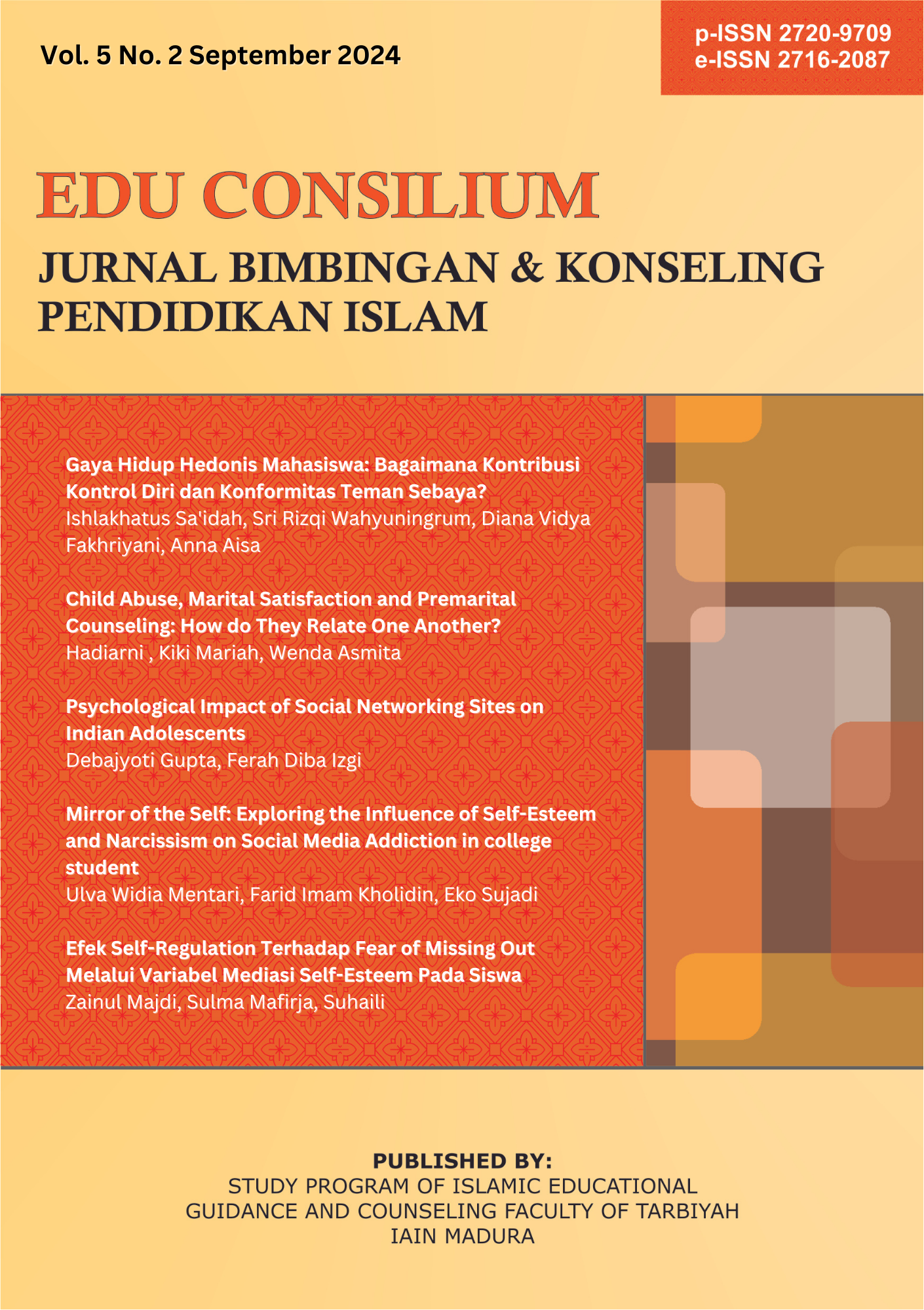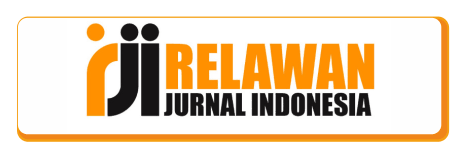Spiritual Emotional Freedom Technique untuk Mereduksi Psikosomatis Pada Ibu Rumah Tangga
 Abstract views: 219
,
Abstract views: 219
,
 PDF downloads: 231
PDF downloads: 231
Abstract
The purpose of this study was to find out whether the Spiritual Emotional Freedom Technique is effective in reducing psychosomatic symptoms in housewives. The research method used is experimental research. This type of research is a one group pretest-posttest design study. Sample data collection in this study used the purposive sampling method. Purposive sampling is a sampling technique with certain considerations. The reason for using this purposive sampling technique is because it is suitable for quantitative research, or studies that do not generalize. Data collection was obtained by filling in psychosomatic problem scale. The analysis used by researchers to determine the influence of each variable uses a non-parametric analysis test technique, namely the Wilcoxon Signed Rank Test. As for testing the hypothesis that reads Spiritual Emotional Freedom Technique is effective for reducing psychosomatic in housewives, based on the results in the table based on the results in the table obtained Z count of -2.023 with Asymp.sig (2-tailed) of 0.043. So it can be concluded that the Spiritual Emotional Freedom Technique is effective for reducing psychosomatic symptoms in housewives.
Downloads
References
Abdurrahman, G. (2022). Terapi Sufistik untuk Penyembuhan Gangguan Kejiwaan. Aswaja Pressindo.
Aini, Q. (2022). Peran Hipnoterapi Dalam Mengatasi Psikosomatis di Pondok Trapi La Tahzan. Jurnal At-Taqaddum, 1(1), 30–39.
Ambarwati, P. D., Pinilih, S. S., & Astuti, R. T. (2019). Gambaran Tingkat Stres Mahasiswa. Jurnal Keperawatan Jiwa, 5(1), 40. https://doi.org/10.26714/jkj.5.1.2017.40-47
Annuar, K., & Nurus Saadah. (2022). Terapi Seft (Spiritual Emotional Freedom Technique) Untuk Mengatasi Kecemasan Belajar Siswa. Counselia; Jurnal Bimbingan Konseling Pendidikan Islam, 3(2), 29–40. https://doi.org/10.31943/counselia.v3i2.41
Apriyani, R. (2018). Faktor-Faktor Penyebab Psikosomatis Pada Orang Dengan Kecenderungan Psikosomatis Di Samarinda. PSIKOBORNEO, 6(3), 609.
Dewi, I. ., & Fauziah, D. (2017). Pengaruh Terapi SEFT Terhadap Penurunan Tingkat Kecemasan Pada Para Pengguna NAPZA. Jurnal Keperawatan Muhammadiah, 2(2), 135–150.
Fakhriyani, D. V., Sa’Idah, I., & Annajih, M. Z. (2021). Pendekatan REBT Melalui Cyber Counseling untuk Mengatasi Kecemasan di Masa Pandemi COVID-19. Counsellia: Jurnal Bimbingan dan Konseling, 11(1), 56-70. http://doi.org/10.25273/counsellia.v11i1.8463
Fanira, S., & Rohmadani, Z. V. (2021). Psikosomatis Ditinjau Dari Self-Resilience yang Dimiliki Mahasiswa Semester Akhir di Universitas ‘Aisyiyah Yogyakarta. Journal of Psychological Perspective, 3(1), 35–39. https://doi.org/10.47679/jopp.311212021
Fava, G. A., Fiammetta, C., & & Nicoletta, S. (2016). Current Psychosomatic Practice. Psychotherapy and Psychosomatics, 86(1), 13–30.
Fitriani, A., Rois, M. M., Fitriani, A., & Rois, M. M. (2014). Studi Kasus Kecenderungan Psikosomatis Dan Kaitannya Dengan Sistem Budaya. Proyeksi, 9(2), 38–48.
Hakim, T. (2004). Mengatasi Gangguan Mental Dan Fisik. Puspa Swara.
Herlena, B., & Seftiani, N. A. (2018). Kecerdasan Spiritual Sebagai Prediktor Kesejahteraan Subjektif Pada Mahasiswa. Jurnal Psikologi Integratif, 6(1), 101. https://doi.org/10.14421/jpsi.v6i1.1473
Hubbard, L. R. (2017). Ilmu Pengetahuan Modern Tentang Kesehatan Mental. (P. Jaya (ed.)).
Huda, S., & Alvita, G. W. (2018). Pengaruh Terapi Seft (Spiritual Emotional Freedom Technique) Terhadap Penurunan Tekanan Darah Pada Penderita Hipertensi Di Wilahah Puskesmas Tahunan. Jurnal Keperawatan Dan Kesehatan Masyarakat Cendekia Utama, 7(2), 114. https://doi.org/10.31596/jcu.v7i2.256
Kawanda, F. H. (2023). Implementasi Terapi Spiritual Emotional Freedom Technique (SEFT) Untuk Menurunkan Kecemasan Pada Pasien Pre-Operasi. Jurnal Ilmu Kesehatan Dan Gizi (JIG), 1(3), 15–24. https://doi.org/10.55606/jikg.v1i3.1270
Lazarus, R. S., & Folkman, S. (2004). Stress Appraisal and Coping. Springer Publishing Company Inc.
Maramis, W. E. (2004). Catatan Ilmu Kedokteran Jiwa. Airlangga University Press.
Maryam, S. (2017). Strategi Coping : Teori Dan Sumberdayanya. Jurnal Konseling Andi Matappa, 1(2), 101–107.
Mayangsari, W., Shinta, A., & Widiantoro, F. X. W. (2022). Studi Kasus Strategi Coping Stres Pada Ibu Rumah Tangga dengan Kecenderungan Psikosomatis di Yogyakarta. 18(1), 37–47.
Nikmarijal. (2019). Upaya Peningkatan Pemahaman Tentang Psikosomatis denganBimbingan dan Konseling Melalui Layanan Informasi di Desa Kota Kapur. Jurnal Pengabdian Masyarakat, 2(2).
Pomerantz, & et al. (2013). Psikologi Klinis. (third ed.). Pustaka Pelajar.
Pratiwi, D & Lailatushifah, S. N. F. (2023). Kematangan Emosi dan Psikosomatis pada Mahasiswa Tingkat Akhir. Jurnal Psikologi., 10(2).
Puji, W. H. (2016). Konseling Client Centered Terhadap Pasien Psikosomatis. Gemala Publisher.
Rajin, M. (2022). Terapi Spiritual Emotional Freedom Tehnique (SEFT) Untuk Meningkatkan Kualitas Tidur Pasien Pasca Operasi di Rumah sakit. Jurnal Penelitian Unipdu, 8(2), 51–79.
Rofacky, H. F. (2015). Pengaruh Pengaruh Spiritual Emotional Freedom Technique (SEFT) terhadap tekanan darah pada Penderita Hipertensi di wilayah Kerja Puskesmas Bergas Kecamanan Bergas Kabupaten Semarang. Jurnal Keperawatan STIKES, 20(4), 186–200.
Sa'idah, I., Aisa, A., Fakhriyani, D. V., & Wahyuningrum, S. R. (2022). DPR (Dengar Pahami Rangkul): community-based intervention untuk meningkatkan kesehatan mental mahasiswa generasi Z di kelurahan Lawangan Daya kecamatan Pademawu kabupaten Pamekasan. PERDIKAN (Journal of Community Engagement), 4(2), 85-93. https://doi.org/10.19105/pjce.v4i2.7705
Sa’idah, I., & Annajih, M. Z. H. (2024). Konsep Dasar Bimbingan & Konseling. Alifba Media
Semiun, Y. (2006). Kesehatan Mental 3. Penerbit Kanisius.
Sugiyono. (2019). Metode Penelitian Kuantitatif, Kualitatif, dan R&D. Alphabet.
Zainuddin. (2015). SEFT : Spiritual Emotion Freedom Techinique. Afzan Publishing.
Zaki, M. (2012). Zaki, M. (). 5 Terapi Sehat. PT. Elex Media Komputindo.
The journal operates an Open Access policy under a Creative Commons Non-Commercial 4.0 International license. Authors who publish with this journal agree to the following terms:
- Authors retain copyright and grant the journal right of first publication with the work simultaneously licensed under a
 Commons Attribution-NonCommercial 4.0 International License
Commons Attribution-NonCommercial 4.0 International Licensethat allows others to share — copy and redistribute the material in any medium or format, and adapt — remix, transform, and build upon the material.
- Authors are able to enter into separate, additional contractual arrangements for the non-exclusive distribution of the journal's published version of the work (e.g., post it to an institutional repository or publish it in a book), with an acknowledgement of its initial publication in this journal.
- Authors are permitted and encouraged to post their work online (e.g., in institutional repositories or on their website) prior to and during the submission process, as it can lead to productive exchanges, as well as earlier and greater citation of published work (see The Effect of Open Access).




















